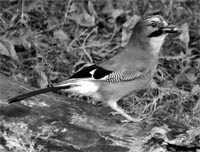The Brent goose is the common goose of Dublin Bay seen on Sandymount
Strand, the Bull Island and more frequently now in Booterstown Marsh. Later
in the winter flocks of Brent can be seen flying down to Wicklow to feed
on the BirdWatch reserve at Kilcoole then flying back up in the evening often
passing through Dalkey Sound, sometimes over 800 birds flying just feet above
the water. They make one of the longest migrations of any goose species flying
from Ireland and the UK to their breeding grounds in Arctic Canada with stopovers
at Iceland and Greenland, a journey of over 3,000 miles. Their flight sometimes
takes them a mile and a half above mountain peaks in Greenland! In late summer
they set off on the return journey, hopefully this time with two or three
offspring in tow. Usually reaching Dublin in September or October - last
year saw some Brent returning in early September. These birds had juveniles
with them and it appeared that the birds had bred early and, being fully
grown and fledged, were subsequently able to set off early on their reverse
migration. This year saw record early arrivals of Brent with a small family
group being seen in late August on Sandymount. Hopefully they’ve had
another good breeding year.
THE
BUM BARREL
Late August brought back some very welcome visitors back to my bird feeders.
A flock of about 20 Long Tailed Tits made their way into the garden and on
to the peanut feeders. I heard them described recently as ‘Flying Lollipops’
a very apt name for these delightful little creatures. Although Goldcrest
are Ireland’s smallest birds if it wasn’t for its 3 inch tail
the Long Tailed Tit would be able to take that title. You might initially
see one individual but there’s always more to come, moving from bush
to bush in large family groups keeping contact with very high pitched calls
and also making a very distinctive little ‘brrup’ like call.
There will sometimes be two or three clinging on to the feeders at the same
time, one bird’s tail sometimes overlapping another bird. Very busy
for a while then they’ll be off to someone else’s garden. Primarily
insect feeders I hadn’t seen them near the feeders all summer and it
was great to have them back. In the past I’ve been refilling the feeders
when
Long Tailed Tits would be perched a few inches away totally unbothered by
my presence and almost urging me to get on with it. Like the tiny Goldcrest
they have to eat constantly since their body size means they can’t
store much fat and can be seen or heard still searching for food in the last
glimmer of evening light when many other birds are already settling down
in cover. Another old English nickname for Long Tailed Tits is the ‘Bum
Barrel’, not a derogatory term but a description of the spherical nest
they weave from feathers then surround on the outside with moss perfectly
camouflaged and well insulated.
My much sharper eyed companion spotted them first as we crossed the peak
of Dalkey Hill. Pinkish brown with a blue wing flash and a white rump: a
pair of Jays. They’d been around Killiney hill all last winter, even
in our garden once. When there was a programme to trap Grey Squirrels on
the hill using acorn baited traps they often found a Jay trapped in the cage,
waiting patiently to be released. Jays, like all members of the crow family
are very intelligent. They possibly knew getting trapped in the cage was
worth a good meal of acorns and were willing to suffer a short term of imprisonment.
Terry Flanagan of RTE’s Mooney Goes Wild programme did a thesis on
Jays many years ago in which he would use live traps to
catch and record details about the local population of jays and he too had
the same Jays constantly getting trapped in his cages! The ones in Killiney
had started to nest build there in early April. I’d seen them carrying
twigs to the nest but hadn’t seen them for the rest of the summer so
I reckon they eventually moved somewhere else to nest. Anyhow great to have
them back. A friend in Killiney had three jays coming to his peanut feeders
and I can only hope they decide to pay ours a visit.

Long Tailed Tit
|



